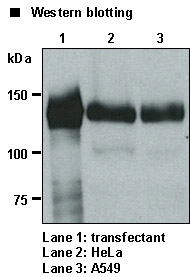Anti-Rubicon (Human) mAb
Product Code:
MBL-M170-3
MBL-M170-3
Host Type:
Mouse
Mouse
Antibody Isotype:
IgG2a κ
IgG2a κ
Antibody Clonality:
Monoclonal
Monoclonal
Antibody Clone:
1H6
1H6
Regulatory Status:
RUO
RUO
Target Species:
Human
Human
Application:
Western Blot (WB)
Western Blot (WB)
Shipping:
4°C
4°C
Storage:
-20°C
-20°C
No additional charges, what you see is what you pay! *
| Code | Size | Price |
|---|
| MBL-M170-3 | 100 ul | £357.00 |
Quantity:
Prices exclude any Taxes / VAT



